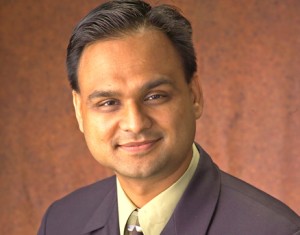One of the world’s leading cardiothoracic surgeons, Amit N. Patel of the University of Utah, is in the news for a pioneering procedure called retrograde gene therapy. The procedure he developed delivers stem cells to the heart, repairing damaged muscle and arteries in the most minimally invasive way possible.
“It’s incredible. Imagine having a heart procedure that can potentially regenerate or rejuvenate your heart muscle — and it’s done as an outpatient procedure,” the Indian American physician said in a statement.
Patel — an educator, inventor, researcher, and clinician already considered a superstar within his field — hit the headlines Nov. 26 after successfully performing surgery at University of Utah Hospital on actor Ernie Lively, the father of “Gossip Girl” star Blake Lively.
Lively became the first patient in the world to undergo retrograde gene therapy after the procedure’s recent FDA approval.
Patel used a minimally invasive technique to insert a catheter through Lively’s main cardiac vein, or coronary sinus. He then inflated a balloon to block blood flow out of the heart so that he could administer a very high dose of gene therapy — pure human DNA — directly into the heart.
This particular DNA, called stromal cell-derived factor 1, or SDF-1, is a naturally occurring substance in the body. It provides a sort of “homing beacon” for the patient’s body to send its own stem cells to go to the site of an injury. Another way the therapy is unique is that this particular therapy does not use viruses, noted Patel.
“The genes basically act like a light house with a bright signal,” Patel said in a University of Utah press release. “They say, ‘How can we help the ships that need to get to the port — which is the heart — get there?’
“When the signal, or the ‘light,’ from the SDF-1, which is that gene, shows up, the stem cells from not inside your own heart and from those that circulate from your blood and bone marrow all get attracted to the heart which is injured, and they bring reinforcements to make it stronger and pump more efficiently.”
Patel is an associate professor in the Division of Cardiothoracic Surgery at the University of Utah School of Medicine, and director of Clinical Regenerative Medicine and Tissue Engineering at the University of Utah.

According to a press release from the University of Utah, Patel has been investigating cell and gene-based therapies for the treatment of heart disease for 12 years. More than 6 million people in the U.S. are dealing with heart failure, and Patel wanted to develop a way to treat it before patients would have to turn to drastic and expensive measures such as a heart transplant or an artificial heart.
“This is one of the great moments in biological therapy for the heart,” Patel said in the press release. “We are providing options for patients who have no possible solutions. This is one of the safest and most reproducible therapies out there for these very sick patients.”
The versatile scientist has many clinical interests, including heart surgery for coronary disease; valve repair and replacement; heart failure; aortic surgery and stent grafts. As a thoracic surgeon, he is an expert in lung and esophageal surgery, and is known for his work in thoracic oncology that includes minimally invasive lung resections and hyperthermic chemotherapy, a form of therapy for mesothelioma that calls for heating a solution of chemotherapeutic drugs for better absorption.
Patel has recently developed a stem cell spray for rapid healing of heart surgery and burns, and he is currently working on a treatment for Type 2 Diabetes. He is now training other physicians around the U.S. in retrograde gene therapy, and is overseeing a trial of the procedure with 72 patients.
Source: IndiaWest
